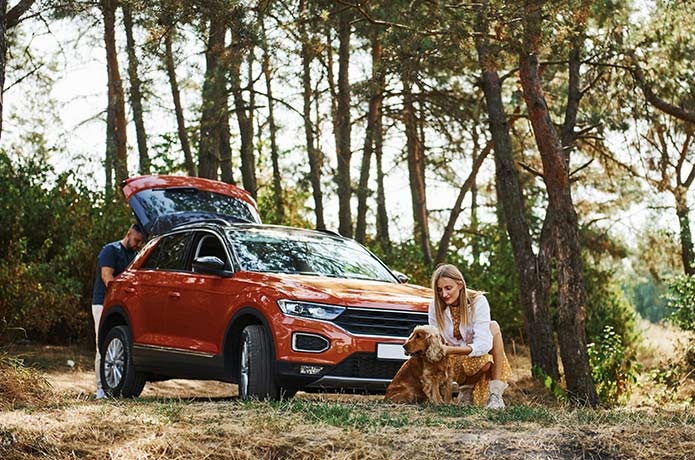Magazine
How to get your dog used to car travel in five steps
Travelling in a car is necessary for most dogs, but many of them can find it incredibly stressful.
Dogs can demonstrate this in a number of ways, including barking, whining, heavy panting, vomiting, or simply refusing to get into the car at all!
The way to overcome this is to help your dog create a positive association with the car. As well as being comfortable in the car, dogs must also be secured, preventing them from distracting the driver or posing any other risks. A well fitting car harness, a boot guard or a cage can help keep you and your dog safe while driving.
Step 1: creating a comfortable and familiar environment
If your dog is happy to get in the car, put a familiar blanket or even a dog bed inside, so they have a soft, comfy space they recognise. This helps them to feel secure, and the bed and blankets can also reduce the likelihood of them losing their balance when in a moving car. If your dog is cage trained, a secured crate can also be a safe and familiar space for them.
Step 2: get your dog used to the car
If your dog shows signs of being nervous around the car, then find some additional time to take them anywhere to get them used to being around the vehicle.
While the engine is switched off and the doors shut, walk your dog around the outside of the car at a sensible distance that they’re comfortable with. Don’t try to force the dog closer to the car, instead, allow them to make their own decision to investigate, when and if they feel comfortable. Reward them with a treat and give praise at any time they calmly look at the car, move toward it or sniff it.
Initially, keep these sessions short, only a couple of laps around the car will do, before having a break. Continue with these steps over time until your dog is comfortable walking near to the car. As soon as you think your pet is comfortable and relaxed outside the car, you can move on to the next step.
Step 3: introduce the interior of the car to your dog
Before you take your dog out to the car, open the door or boot, (wherever you want it to feel comfortable) and put some of their blankets inside, with the engine still off. Then walk them around the car again and give a reward as they move towards an open door and investigate.
Once your dog is relaxed around the open door, approach it and place a treat just inside, somewhere like the outer foothold, where the dog can still see it but doesn’t have to go into the car to get it. When your dog is comfortable taking treats, gradually move them further into the car until they are eventually having to climb in to get the treat. If the dog is hesitant at all, then go back a step and build it back up. You can also try getting into the car yourself, as your dog may feel more comfortable following you in.
Once your dog is happy to hop in and out of the car, you can build up the amount of time they’re in there during your sessions. To do this, find some time to sit in the car with them and give them a long lasting treat like a chew. This will build a positive association with being inside the car as they get to enjoy a treat and spend time with you! When your dog is relaxed being inside the car, you can move on to the next step.
Step 4: closing the car door
If your dog shows signs of being nervous around the car, then find some additional time to take them anywhere to get them used to being around the vehicle.
While the engine is switched off and the doors shut, walk your dog around the outside of the car at a sensible distance that they’re comfortable with. Don’t try to force the dog closer to the car, instead, allow them to make their own decision to investigate, when and if they feel comfortable. Reward them with a treat and give praise at any time they calmly look at the car, move toward it or sniff it.
Initially, keep these sessions short, only a couple of laps around the car will do, before having a break. Continue with these steps over time until your dog is comfortable walking near to the car. As soon as you think your pet is comfortable and relaxed outside the car, you can move on to the next step.
Step 5: driving off
As soon as your dog is familiar and not stressed with the sound of the engine, you can begin to go for some practice drives. Keep them very short initially, perhaps going down the street and back again, and make sure that it is a slow and smooth journey, before gradually increasing the travelling distances. When you build up the length of the journeys, make sure your first real trips are to take your dog to places for nice walks and fun activities and not too far away. This will build the positive association that most of the time getting in the car means going to fun places.

